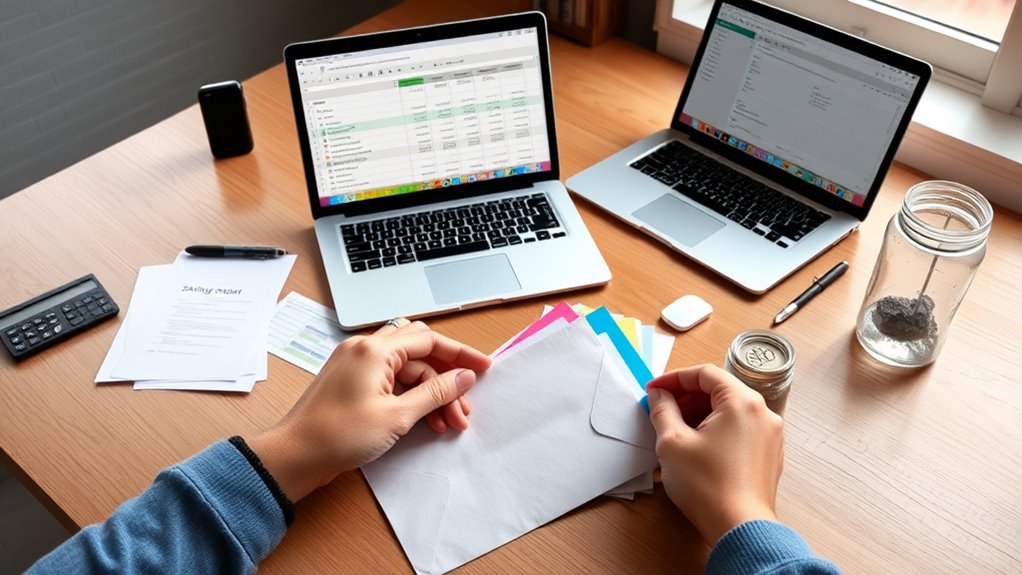Start by reviewing your income, expenses, and debts to see what you can save each month. Set a clear goal of saving three to six months’ worth of living expenses, then break it into manageable monthly targets. Automate your savings and prioritize paying off high-interest debt first. Track your progress regularly, celebrate milestones, and resist the urge to dip into your emergency fund prematurely. Keep going, and you’ll build a safety net that offers peace of mind for future surprises.
Key Takeaways
- Assess your current financial situation, including income, expenses, and debt, to determine how much you can save monthly.
- Set a realistic savings goal, aiming for three to six months’ worth of living expenses as an emergency fund.
- Create a dedicated savings account and automate regular transfers to build your fund consistently.
- Prioritize paying off high-interest debt to free up more money for emergency savings.
- Track your progress, celebrate milestones, and avoid dipping into the fund unless true emergencies occur.

Have you ever wondered how to prepare for unexpected financial setbacks? Building an emergency fund is your first step toward financial security, and it requires strategic planning and disciplined habits. To start, you need a clear understanding of your financial situation. Review your income, expenses, and existing debt. This will help you determine how much you can realistically save each month. While some may focus solely on saving, it’s equally important to consider investment strategies that can support your goal without risking your financial stability. For instance, keeping your emergency fund in a high-yield savings account ensures easy access while earning some interest. Avoid putting this money into long-term investments that could lock you in or cause penalties if you need quick access.
Building an emergency fund requires strategic planning, disciplined habits, and understanding your financial situation for lasting security.
Debt management plays a vital role during this process. If you have high-interest debt, it’s smart to prioritize paying it down before aggressively saving. The interest on credit cards or personal loans can quickly eat into your savings, making it harder to build that safety net. By reducing your debt load, you free up more cash flow for saving, and you decrease your financial vulnerability. As you manage debt efficiently, you’ll create more room in your budget for consistent contributions to your emergency fund. Remember, the goal isn’t to eliminate debt overnight but to strike a balance that steadily increases your savings without neglecting your repayment obligations.
Next, set a specific target for your emergency fund—typically three to six months’ worth of living expenses. Break this goal into manageable milestones, such as saving a certain amount every month. Automate your savings by setting up automatic transfers from your checking account to your dedicated emergency fund. This removes the temptation to spend what you intend to save and guarantees consistency. If your income fluctuates or you encounter unexpected expenses, adjust your contributions accordingly, but avoid completely skipping savings.
Track your progress regularly to stay motivated. Celebrate small wins along the way, like reaching the halfway point of your initial goal. As your fund grows, stay vigilant and avoid dipping into this money unless it’s an emergency. Resist the urge to use these funds for non-essential purchases, as it can set back your progress and leave you unprepared for real crises. Remember, building an emergency fund isn’t a one-time effort but a continuous process that reinforces your financial resilience. By combining disciplined debt management with smart investment strategies and consistent saving habits, you’ll build a robust safety net that offers peace of mind during life’s uncertainties. Additionally, understanding the variety of water parks available in your area can provide fun and relaxing ways to enjoy your time while managing your budget effectively.
Frequently Asked Questions
How Much Should I Aim to Save in My Emergency Fund?
You should aim to save enough to cover three to six months of living expenses, depending on your job stability and personal circumstances. Don’t fall for emergency fund myths that suggest more is always better—focus on realistic goals. Consider smart investment strategies for your savings, but prioritize liquidity so you can access funds quickly when needed. Regularly review and adjust your target as your financial situation changes.
When Is the Best Time to Start Building an Emergency Fund?
Starting now is the best time to build your emergency fund—waiting is like missing out on a life raft in a storm. Timing considerations matter, so aim to reach emergency fund milestones as soon as possible. The earlier you begin, the faster you’ll secure financial peace of mind. Don’t wait for the “perfect moment”; every day you delay, you risk missing out on crucial protection against unexpected setbacks.
Can I Use High-Interest Savings Accounts for My Emergency Fund?
Yes, you can use high-interest savings accounts for your emergency fund. They offer attractive interest rates compared to regular savings accounts, helping your money grow faster. These accounts are also a safe investment option, providing quick access when you need it. Just guarantee the interest rates remain competitive, and avoid riskier investment options that could jeopardize your emergency fund’s liquidity and safety.
What if I Have Debt—Should I Prioritize That Over Saving?
If you’ve got debt, don’t ignore it completely. Debt prioritization can feel like trying to juggle flaming torches while walking a tightrope, but savings timing is essential. Strike a balance—pay down high-interest debt first to save on interest, then build your emergency fund. This way, you’re not throwing money into a black hole, and you’ll secure your financial future faster, avoiding disaster when life throws curveballs.
How Often Should I Review and Adjust My Emergency Fund?
You should review and adjust your emergency fund at least once a year, especially during major life changes or shifts in your financial situation. Regular reviews help you stay aligned with your investment planning goals and guarantee your fund covers current needs. Staying informed through financial education allows you to make smarter adjustments, balancing your emergency fund with other financial priorities. Consistent review keeps your safety net effective and your finances secure.
Conclusion
Building an emergency fund is a smart move—you’ll gain peace of mind and financial security. Did you know that 40% of Americans can’t cover a $400 emergency? That’s a huge gap in safety net. By following these simple steps, you can start saving today and avoid stressful debt when unexpected expenses hit. Remember, even small contributions add up over time. Take control of your finances now—you’ll thank yourself later!









